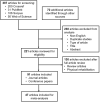A Systematic Review of Robotic Rehabilitation for Cognitive Training
- PMID: 34046433
- PMCID: PMC8144708
- DOI: 10.3389/frobt.2021.605715
A Systematic Review of Robotic Rehabilitation for Cognitive Training
Abstract
A large and increasing number of people around the world experience cognitive disability. Rehabilitation robotics has provided promising training and assistance approaches to mitigate cognitive deficits. In this article, we carried out a systematic review on recent developments in robot-assisted cognitive training. We included 99 articles in this work and described their applications, enabling technologies, experiments, and products. We also conducted a meta analysis on the articles that evaluated robot-assisted cognitive training protocol with primary end users (i.e., people with cognitive disability). We identified major limitations in current robotics rehabilitation for cognitive training, including the small sample size, non-standard measurement of training and uncontrollable factors. There are still multifaceted challenges in this field, including ethical issues, user-centered (or stakeholder-centered) design, the reliability, trust, and cost-effectiveness, personalization of the robot-assisted cognitive training system. Future research shall also take into consideration human-robot collaboration and social cognition to facilitate a natural human-robot interaction.
Keywords: cognitive disability; human-robot interaction; multimodal interaction; rehabilitation robotics; robot-assisted cognitive training; socially assistive robotics.
Copyright © 2021 Yuan, Klavon, Liu, Lopez and Zhao.
Conflict of interest statement
The authors declare that the research was conducted in the absence of any commercial or financial relationships that could be construed as a potential conflict of interest.
Figures
References
-
- Ab Aziz A., Ahmad F., Yusof N., Ahmad F. K., Yusof S. A. M. (2015). Designing a robot-assisted therapy for individuals with anxiety traits and states, in 2015 International Symposium on Agents, Multi-Agent Systems and Robotics (ISAMSR) (Putrajaya: IEEE; ), 98–103. 10.1109/ISAMSR.2015.7379778 - DOI
-
- Abdollahi H., Mollahosseini A., Lane J. T., Mahoor M. H. (2017). A pilot study on using an intelligent life-like robot as a companion for elderly individuals with dementia and depression, in 2017 IEEE-RAS 17th International Conference on Humanoid Robotics (Humanoids) (Birmingham: IEEE; ), 541–546. 10.1109/HUMANOIDS.2017.8246925 - DOI
-
- Adam C., Johal W., Pellier D., Fiorino H., Pesty S. (2016). Social human-robot interaction: a new cognitive and affective interaction-oriented architecture, in International Conference on Social Robotics (Springer: ), 253–263. 10.1007/978-3-319-44884-8 - DOI
-
- Agrigoroaie R., Ferland F., Tapus A. (2016). The enrichme project: Lessons learnt from a first interaction with the elderly, in International Conference on Social Robotics (Kansas City, MO: Springer; ), 735–745. 10.1007/978-3-319-47437-3_72 - DOI
-
- Agrigoroaie R. M., Tapus A. (2016). Developing a healthcare robot with personalized behaviors and social skills for the elderly, in 2016 11th ACM/IEEE International Conference on Human-Robot Interaction (HRI) (Christchurch: IEEE; ), 589–590. 10.1109/HRI.2016.7451870 - DOI
Publication types
LinkOut - more resources
Full Text Sources
Other Literature Sources


